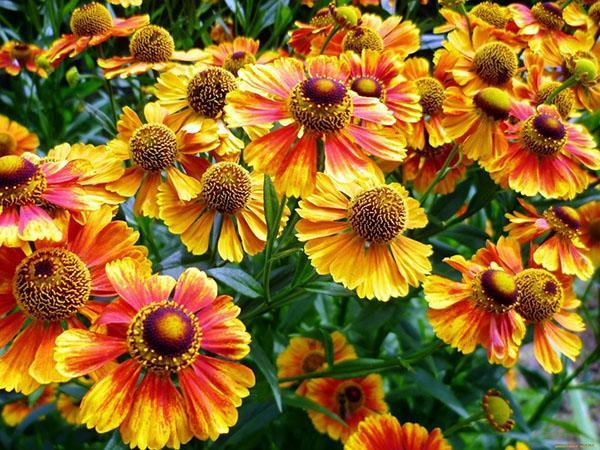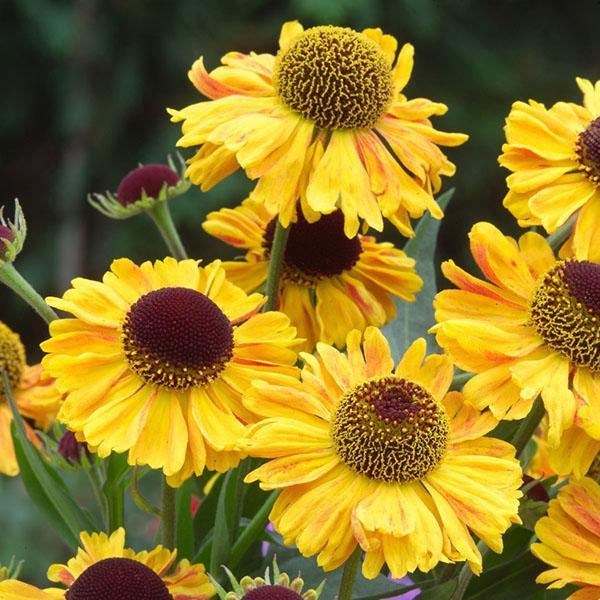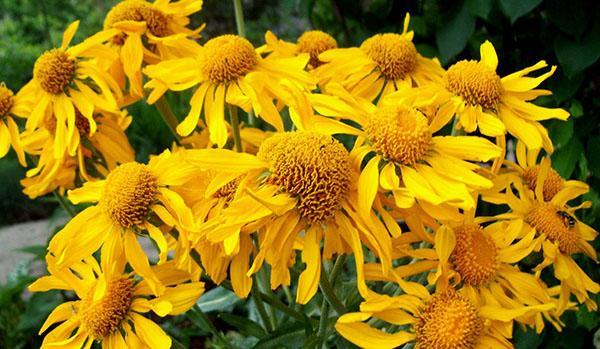Successful cultivation of helenium from seeds in the open field
 The correct cultivation of helenium from seeds is the key to a beautiful and healthy plant. If you observe the planting time, choose the right site and adhere to watering and feeding, then this autumn perennial forms a lush bush with many colorful flowers.
The correct cultivation of helenium from seeds is the key to a beautiful and healthy plant. If you observe the planting time, choose the right site and adhere to watering and feeding, then this autumn perennial forms a lush bush with many colorful flowers.
Gelenium: main types and their description

The flower is distinguished by strong peduncles, which dry out at the onset of the first frost.
Today, there are about 30 different types of helenium. The presented plant does not have the shape of a bush. Gelenium is a single specimen that is close to each other.
The stems are all straight, even. Their height reaches 160 cm. The leaves are lanceolate, arranged alternately. The buds are collected in inflorescences that resemble the shape of a basket.
The main types of gelenium:
- Chuppah. This type is often referred to as a hoopesa. In nature, it prefers to grow in rocky areas. The height of the shoots does not exceed 1 m. The stems of the Hupa helenium are straight, strongly branched in the upper part. The leaves are deep green with a brown tint. Flowers are single. They reach 8 cm in diameter and are yellow. Flowering can be observed in late June or early July.

- Gelenium Autumn Jazz. This is one of the most beautiful varieties. The plant grows up to 1.2 m in height. The flowers are beautiful and large. They are presented in the form of chamomile. In diameter, the opened bud reaches 6 cm. The petals acquire a rich yellow, brown or burgundy hue, slightly cut at the ends.

- Gelenium Ranchera. The flower grows no higher than 1.5 m. The leaves are longish, slightly pointed at the ends. The buds are small. The petals have a deep red hue. Less commonly, they can acquire a reddish or yellowish color and a purple center.

- Gelenium Chelsea. This is the hybrid that blooms first. Initially, the buds have a red tint, but over time, a yellowish tone appears on them. By the end of summer, the petals turn orange. The flowers are wheel-shaped. The stems are not tall.

- Gelenium Rubintswerg. This variety also applies to hybrids. The plant reaches 65 cm in height. The flowers are basket-shaped. The petals are ruby red. It begins to bloom in the second part of July.

Autumn helenium is no less popular. The variety is distinguished by bright colors that do not lose their attractiveness for many months.
Growing helenium from seeds
 It is not necessary to have special skills to grow a new plant. It is enough to adhere to the planting time, carry out the preparatory work correctly and follow the simple care instructions.
It is not necessary to have special skills to grow a new plant. It is enough to adhere to the planting time, carry out the preparatory work correctly and follow the simple care instructions.
Seed sowing methods
This method of reproduction is often used by those who are used to controlling the entire process of growing plants. The planting of grains is carried out both in boxes and directly into the open ground. For seedlings, sowing seeds is carried out in the second part of February or at the beginning of March. When it comes to planting in open ground, the best time is autumn. During the winter, the planting material will undergo a natural process of stratification.
Planting seedlings
 It is recommended to sow seeds in long containers.It is best if they are made of wood or durable plastic. The substrate for helenium must be used nutritious. A good option is a soil that is designed for flowering plants.
It is recommended to sow seeds in long containers.It is best if they are made of wood or durable plastic. The substrate for helenium must be used nutritious. A good option is a soil that is designed for flowering plants.
Don't forget about drainage. For this, you can use medium-sized crushed stone or broken brick. Then the soil is poured. The grains are sown on the surface, without burying them in the ground. The planting material is lightly covered with a ball of sand. For quick germination, it is recommended to cover the container with polyethylene.
If everything is done correctly, then the first shoots will appear in a month.
It is necessary to keep containers in a room where the air temperature is within +200 C. After the appearance of two full-fledged leaves, the seedlings dive. You can plant flowers in any container. But it is best if peat pots are used for planting.
Planting seedlings in open ground
 Seedlings are planted in a flower bed in the second part of May or early June. At this time, the soil is already well warmed up, which is very important for helenium.
Seedlings are planted in a flower bed in the second part of May or early June. At this time, the soil is already well warmed up, which is very important for helenium.
The site should be well lit by the sun and protected from drafts. As for the soil, it is best to plant in a slightly acidic and nutritious soil that perfectly permeates moisture.
Before planting seedlings on a flower bed, the site is carefully dug up, everything is removed weeds and rubbish. You will also need to add compost and make dimples.
As soon as the place is prepared, start planting. First you need to get the seedlings from the pots and put them in water so that the root system is saturated with water. After 20-30 minutes, the plants are transferred to the soil.
Proper care of helenium in the garden
It is not difficult to care for this type of plant. The main thing is to know the features that the flower possesses.
Irrigation

To water helenium is needed often and abundantly. Drought is detrimental to perennials. After each procedure, it is recommended to loosen the soil and remove weeds. This is very important, since a lack of oxygen and a crust that forms on the surface of the soil can lead to wilting.
Flowers that are seed-planted will begin to bloom in the second year.
Plant fertilization
 It is necessary to feed helenium three times per season. The first fertilization is applied in the last days of May. To do this, stir 20 g in 10 liters of pure water urea... The resulting solution is poured over the flowers. Potassium sulfate can also be used.
It is necessary to feed helenium three times per season. The first fertilization is applied in the last days of May. To do this, stir 20 g in 10 liters of pure water urea... The resulting solution is poured over the flowers. Potassium sulfate can also be used.
The second feeding is carried out during active development. To do this, use Agricola-7 or Agricola-fantasy. Any of these preparations is combined with 1 liter of cow dung and 10 liters of water.
The last procedure is carried out in the second part of October. It is necessary for the flower to survive the winter well, gain strength and delight with abundant flowering. To do this, dilute 20 g of potassium sulfate and superphosphate in 10 liters of liquid.
Transfer
To have a lot of flowers, and they have a bright color, it is necessary to plant a helenium every two or three years. To do this, the root system is divided into several parts and transplanted to another suitable place.
Diseases and pests
Perennial is quite resistant to various diseases. But despite this, the plant is sometimes affected by the chrysanthemum nematode. It destroys both leaves and buds. Because of this, they turn brown and dry out.
Getting rid of a nematode is not difficult. To do this, you will need to remove all affected shoots, and pour the flower itself with a weak solution of sulfur or lime milk.
If you follow all the rules of care, then no insects and diseases are terrible for the helenium. The flower will delight for many years with its beautiful shoots and attractive, bright buds.
Planting seeds in open ground
 If you decide to sow seeds immediately on a flower bed, then you need to do this just before the frosts so that they do not have time to rise.
If you decide to sow seeds immediately on a flower bed, then you need to do this just before the frosts so that they do not have time to rise.
First, the garden must be dug up.If the soil is heavy, clayey, then it is fertilized with humus and a small amount of sand is added.
Once the site is prepared, you can begin to form the grooves. The distance between the holes should be within 30-35 cm. The seeds are sown not thickly, otherwise you will have to break through.
As soon as the seedlings appear on the surface, care must be taken that they are not drowned out by weeds. When the plants reach 10 cm in height, you can begin to plant them, observing distances of 25 to 30 cm.
 Freshly transplanted specimens are watered every day. It is best to do this in the evening after the sun goes down. The water should be warm and clean.
Freshly transplanted specimens are watered every day. It is best to do this in the evening after the sun goes down. The water should be warm and clean.
Rainwater can also be used for irrigation, but it should be at room temperature.
Propagation of helenium by dividing the bush
This is one of the easiest breeding methods. To grow young in this way, it is necessary to properly divide the root system.
Initially, you need to dig a bush along with an earthen lump. Then, using a knife or other sharp object, divide it into several parts. At the same time, it is important to ensure that the root mass is at least 20 cm in diameter. Move the prepared planting material into a dimple and cover it with soil. Tamp the soil on top a little and water abundantly.
When planting, it is necessary to ensure that the root collar is above the soil surface.
Wintering gelenium
 Despite the fact that this plant is completely winter-hardy, there is a possibility of its freezing. In order for a flower to survive the winter well, it is necessary to mulch it every year. Sawdust or spruce branches are an excellent option. In areas where severe frosts are observed, the root system is covered with a non-woven cloth.
Despite the fact that this plant is completely winter-hardy, there is a possibility of its freezing. In order for a flower to survive the winter well, it is necessary to mulch it every year. Sawdust or spruce branches are an excellent option. In areas where severe frosts are observed, the root system is covered with a non-woven cloth.
Adult specimens are recommended to be cut before shelter. Do this with a sharp knife or garden shears.
They remove the shelter immediately after the snow melts.
Gelenium is a unique flower that, if properly planted, will delight you with its bright colors for many years. Due to its decorative properties, perennials are often used to create landscape design. It looks great in large flower beds, near ornamental shrubs. The plant also goes well with autumn types of flowers.
We live in Karelia! Gelenium has not yet come out of the ground, although the snow has melted for about a month. Well, it's still very cold. Should I be afraid that it is frozen out even though it is planted on the sunny side ?!
Melted snow is not yet an indicator, because the temperature outside should be above zero, and the soil should warm up for the flowers to rise. I think we need to wait until it gets warmer. Both the old overwintered bushes and the seeds planted in the fall will simply sprout a little later, when spring comes not only according to the calendar. Only helenium, which was planted in the fall not with seeds, but with seedlings, can cause concern. Here they could completely disappear, especially if the planting was late and the flowers did not hide.